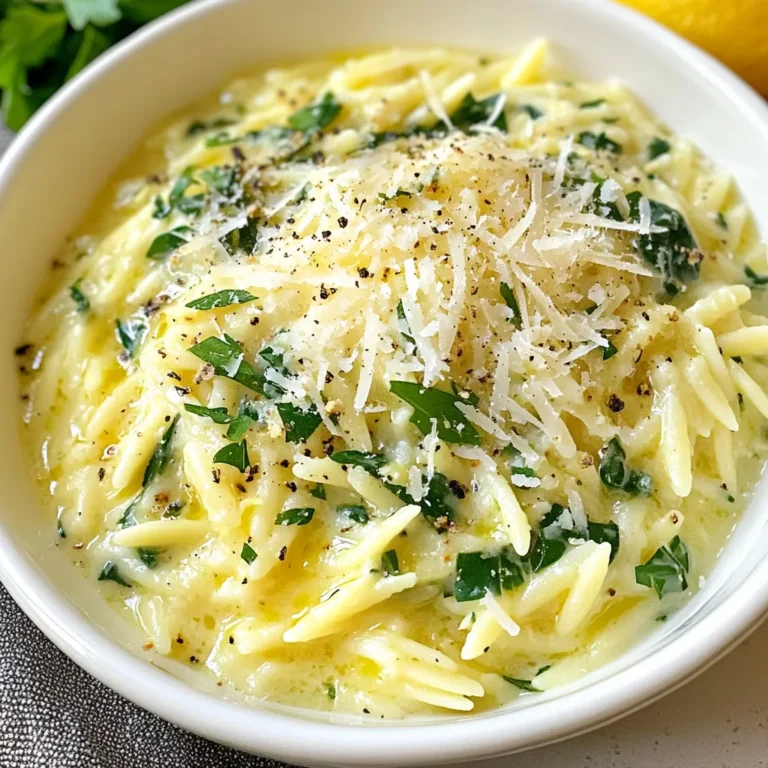Chimichurri Chicken Thighs Flavorful and Easy Recipe
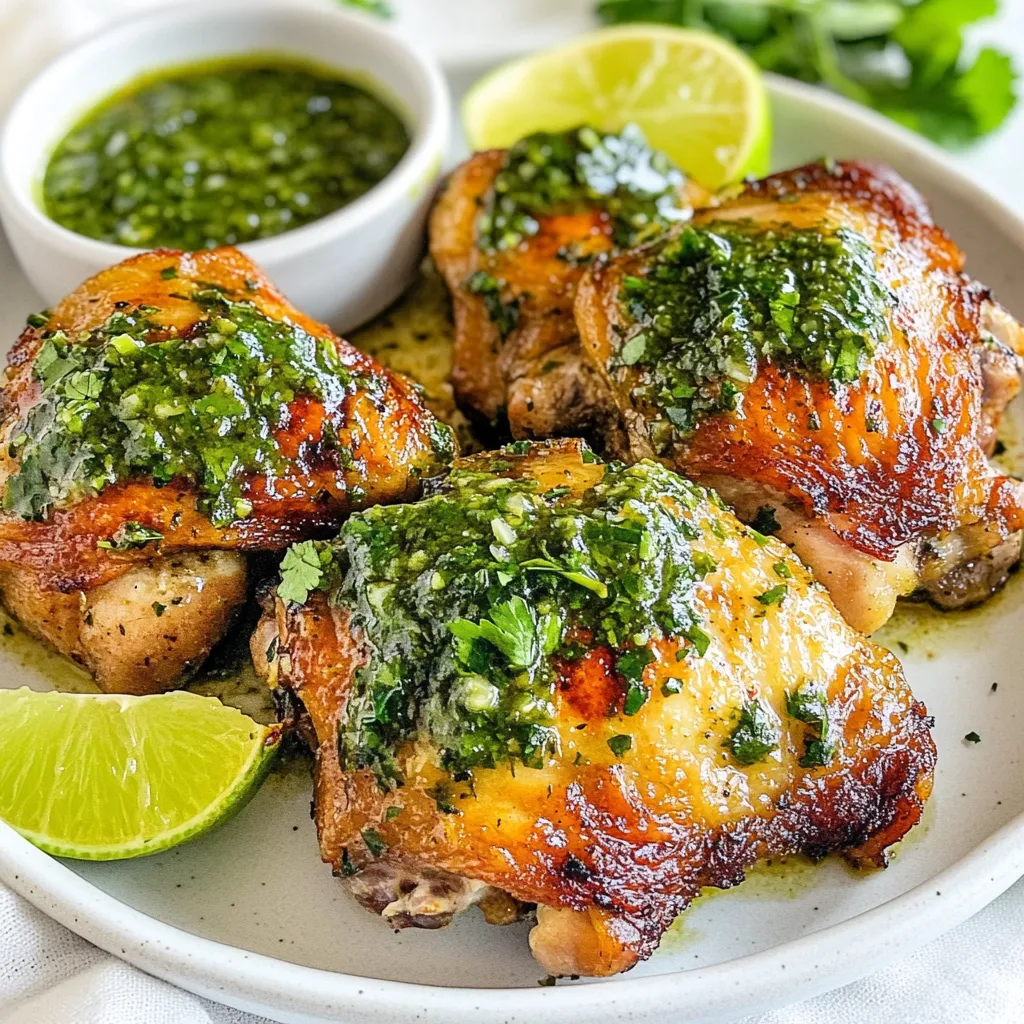
Looking for a delicious and easy chicken recipe? You’re in the right spot! My Chimichurri Chicken Thighs are packed with flavor and perfect for any meal. This dish combines juicy chicken thighs with a fresh, zesty chimichurri sauce that will impress your family and friends. Stick around, and I’ll walk you through every step, from crafting the perfect sauce to cooking methods. Let’s dive into this tasty adventure!
Why I Love This Recipe
- Fresh and Flavorful: This recipe brings together vibrant herbs and spices that create a refreshing and zesty chimichurri, enhancing the chicken’s natural flavor.
- Easy to Prepare: With simple ingredients and straightforward steps, this dish is perfect for both beginner and experienced cooks.
- Versatile Cooking Methods: Whether you choose to roast it in the oven or grill it outdoors, the chicken turns out deliciously juicy and tender every time.
- Impressive Presentation: This dish not only tastes amazing but also looks stunning on the table, making it ideal for family gatherings or special occasions.
Ingredients
List of Ingredients Required
To make chimichurri chicken thighs, you need the following ingredients:
- 4 bone-in, skin-on chicken thighs
- 1 cup fresh parsley, meticulously chopped
- ½ cup fresh cilantro, finely chopped
- 4 cloves of garlic, minced finely
- 1 teaspoon red pepper flakes (adjust for spice preference)
- ½ teaspoon smoked paprika
- ½ teaspoon salt (or to taste)
- ½ teaspoon black pepper (or to taste)
- ½ cup extra virgin olive oil
- 2 tablespoons red wine vinegar (or substitute with lemon juice for a non-alcoholic version)
- 1 lime, juiced
Optional Ingredient Substitutions
You can swap ingredients based on your taste. Try these options:
- Use fresh basil instead of parsley for a different flavor.
- Replace cilantro with mint for a fresh twist.
- Lemon juice can replace red wine vinegar for a brighter taste.
- Adjust red pepper flakes to control heat.
- For a smoky taste, use chipotle powder instead of smoked paprika.
Recommended Quality of Ingredients
When cooking, quality matters. Here’s what to look for:
- Choose fresh herbs. Look for vibrant colors and strong scents.
- Use high-quality extra virgin olive oil. It enhances flavor and adds richness.
- Select chicken thighs with firm skin and no discoloration.
- Fresh garlic adds zest. Avoid garlic that is dried out or sprouted.
- If possible, use organic ingredients. This choice supports better taste and health.
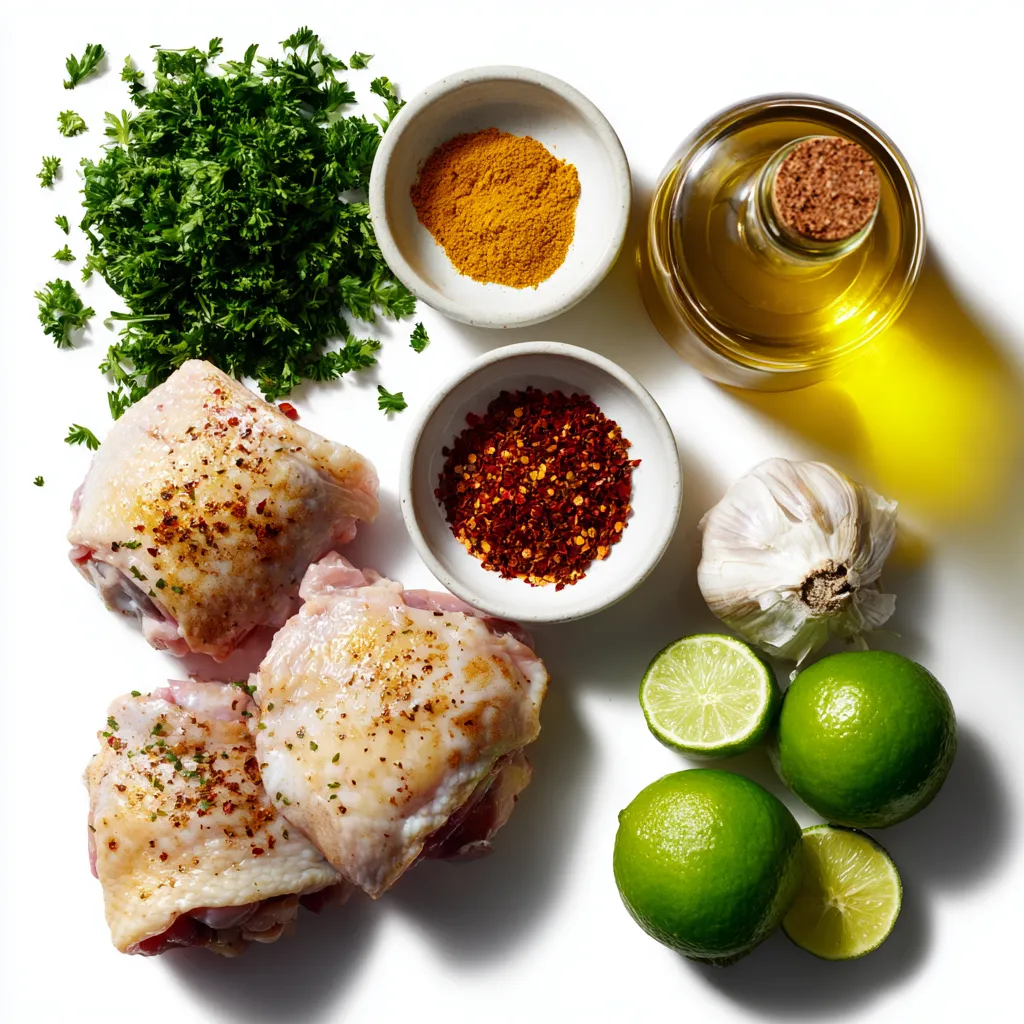
Step-by-Step Instructions
Crafting the Chimichurri Sauce
Start by gathering your ingredients. You need fresh parsley, cilantro, garlic, red pepper flakes, smoked paprika, salt, and black pepper. Chop the parsley and cilantro finely. Mince the garlic well. In a bowl, combine these dry ingredients. Mix them thoroughly to blend the flavors. Next, add the olive oil and red wine vinegar. You can use lemon juice instead if you prefer. Finally, squeeze in the fresh lime juice. Whisk everything together until it turns into a vibrant sauce. This chimichurri will add bright flavors to your chicken.
Marinating the Chicken Thighs
Take your chicken thighs and put them in a large zip-top bag or a shallow dish. Pour half of the chimichurri sauce over the chicken. Make sure each piece is coated evenly. Seal the bag tightly or cover the dish with plastic wrap. Place it in the fridge and let it marinate. The chicken should sit for at least 1 hour. If you have time, marinate it for up to 4 hours. This step makes the chicken flavorful and juicy.
Cooking Methods (Oven vs. Grill)
When ready to cook, preheat your oven to 425°F (220°C). If grilling, heat the grill to medium-high. For oven cooking, line a baking sheet with parchment paper. Take the marinated chicken out of the fridge. Place the thighs on the sheet or grill. Bake for 30-35 minutes or until the skin is crispy and the internal temperature reaches 165°F (75°C). For grilling, cook about 6-8 minutes per side. Keep an eye on it to ensure even cooking.
Basting Techniques for Flavor
In the last 5 minutes of cooking, take the remaining chimichurri sauce. Use a brush to apply it over the chicken thighs. This adds extra flavor and moisture. Basting helps keep the chicken juicy and enhances the overall taste. After cooking, let the chicken rest for 5 minutes before serving. This allows the juices to settle and makes each bite tender and tasty. Enjoy your flavorful chimichurri chicken thighs!
Tips & Tricks
Best Marination Practices for Maximum Flavor
To get the best flavor from your chimichurri chicken thighs, marination is key. First, always use fresh herbs for the chimichurri sauce. Fresh parsley and cilantro add a punch. I recommend marinating the chicken for at least one hour. For a bolder taste, let it sit for up to four hours. Make sure to coat all parts of the chicken well with the sauce. This helps the flavors seep in deeply.
Cooking Time Adjustments for Different Ovens/Grills
Cooking times can change based on your oven or grill type. For a conventional oven set at 425°F, plan for 30 to 35 minutes. If you use a convection oven, check the chicken at 25 minutes. For grilling, the thighs need about 6 to 8 minutes per side. Always check the internal temperature. It should reach 165°F for safe eating.
How to Achieve Crispy Skin
Crispy skin makes any chicken dish special. To achieve this, start with skin-on chicken thighs. Pat the skin dry with paper towels before marinating. A dry surface helps it crisp up better. When cooking, place the thighs skin-side up. If grilling, avoid moving them around too much. Let them sear to form a nice crust. Lastly, baste with chimichurri sauce in the last 5 minutes to keep it moist and flavorful.
Pro Tips
- Quality Ingredients: Using fresh, high-quality herbs and spices will significantly enhance the flavor of your chimichurri sauce, making your chicken thighs even more delicious.
- Marinating Time: For the best flavor, allow the chicken to marinate for at least 4 hours, or even overnight if possible. This gives the meat time to absorb all the flavors of the chimichurri.
- Grill Marks: If grilling, ensure your grill is hot enough before placing the chicken on it. This helps achieve beautiful grill marks and prevents sticking.
- Resting Time: Always let the chicken rest for a few minutes after cooking. This allows the juices to redistribute, making the chicken more tender and juicy when served.
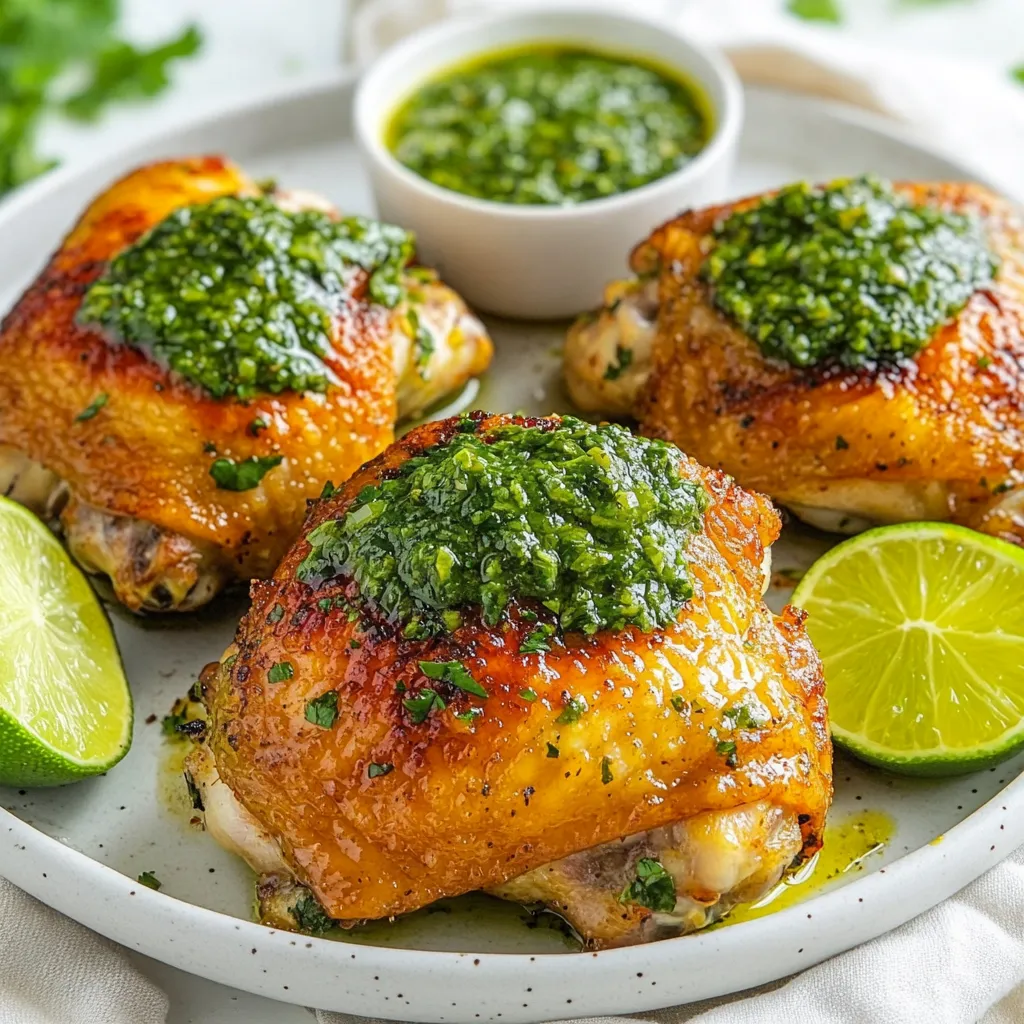
Variations
Alternative Proteins for Chimichurri Sauce
Chimichurri sauce is not just for chicken. You can use it with many proteins. Try it with steak, pork, or fish. Shrimp also works well with this sauce. Each protein absorbs the flavors in its own way, making it a versatile choice. You can even use tofu or tempeh for a plant-based option. Just remember to marinate them like you would the chicken.
Creative Uses for Leftover Chimichurri Sauce
If you have leftover chimichurri sauce, don’t throw it away! Use it in many ways. It makes a great salad dressing. Just mix it with some greens for a fresh taste. You can also drizzle it on roasted vegetables. It adds a zingy touch. Another idea is to use it as a sandwich spread. It gives your meals an extra kick. Pair it with grilled meats or even as a dip for bread.
Different Spice Levels: Adjusting Heat
You can easily change the spice level of your chimichurri sauce. If you like it mild, use fewer red pepper flakes. For a bolder flavor, add more flakes or even some fresh chili. You can also try adding jalapeños for a fresh heat. Adjust the spice to fit your taste. Remember, everyone has a different preference, so make it your own!
Storage Info
Proper Ways to Store Leftover Chicken
To keep your leftover chimichurri chicken thighs fresh, store them in an airtight container. Place the chicken in the fridge. Use it within three days for the best taste. If you want to keep it longer, freezing is a great option.
Freezing Chimichurri Sauce
Chimichurri sauce can freeze well too! Pour it into an ice cube tray. Once frozen, pop the cubes into a zip-top bag. You can use them later by thawing the amount you need. This method keeps the sauce fresh for up to three months.
Reheating Tips for Best Flavor
When you reheat the chicken, do it gently. Use the oven or microwave. If you use the oven, set it to 350°F (175°C). Heat until warm, about 15-20 minutes. In the microwave, cover the chicken and heat in short bursts. This keeps it juicy! If you have extra chimichurri, drizzle some on top for added flavor.
FAQs
How Long Should I Marinate the Chicken?
You should marinate the chicken for at least 1 hour. This helps the flavors soak in deeply. If you have time, let it marinate for up to 4 hours. This gives the chicken a bold and tasty flavor. Just remember to keep it in the fridge while marinating.
Can I Use Boneless Chicken Thighs?
Yes, you can use boneless chicken thighs. They cook faster than bone-in thighs. Adjust the cooking time to about 20-25 minutes. Check the internal temperature to ensure it reaches 165°F (75°C). Boneless thighs still soak up the chimichurri flavor well.
What to Serve with Chimichurri Chicken Thighs?
Chimichurri chicken thighs pair well with many sides. Here are some great options:
- Roasted vegetables
- Rice or quinoa
- A fresh salad
- Grilled corn on the cob
These sides balance the chicken’s rich flavor and add color to your meal.
How to Tell if Chicken is Fully Cooked?
To check if chicken is fully cooked, use a meat thermometer. Insert it into the thickest part of the thigh. It should read 165°F (75°C). If you don’t have a thermometer, cut into the chicken. The juices should run clear, not pink. Always be safe to ensure your meal is delicious and safe to eat.
This blog post showed you how to make delicious chimichurri chicken thighs. We covered key ingredients, cooking methods, and tips for maximum flavor. Remember, marinate your chicken well and choose the right cooking method for your grill or oven. You can get creative with ingredient swaps and spice levels too. Lastly, store your leftovers properly for the best taste. With this guide, you can enjoy tasty meals every time. Happy cookin
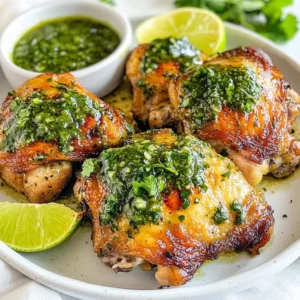
Chimichurri Chicken Thighs
Ingredients
- 4 pieces bone-in, skin-on chicken thighs
- 1 cup fresh parsley, meticulously chopped
- 0.5 cup fresh cilantro, finely chopped
- 4 cloves garlic, minced finely
- 1 teaspoon red pepper flakes
- 0.5 teaspoon smoked paprika
- 0.5 teaspoon salt
- 0.5 teaspoon black pepper
- 0.5 cup extra virgin olive oil
- 2 tablespoons red wine vinegar
- 1 piece lime, juiced
Instructions
- Craft the Chimichurri Sauce: In a medium mixing bowl, combine the finely chopped parsley, cilantro, minced garlic, red pepper flakes, smoked paprika, salt, and black pepper. Stir all the ingredients together until well-mixed.
- Incorporate the Liquids: Gradually add the olive oil and red wine vinegar into the bowl. Squeeze in the fresh lime juice. Whisk the mixture continuously until all components are fully integrated and a vibrant sauce forms.
- Marinate the Chicken: Place the chicken thighs in a large zip-top plastic bag or a shallow dish. Pour half of the prepared chimichurri sauce over the chicken pieces, making sure they are evenly coated. Seal the bag or cover the dish with plastic wrap, and let marinate in the refrigerator for at least 1 hour (and up to 4 hours for a bolder flavor).
- Preheat for Cooking: When you’re ready to cook, preheat your oven to 425°F (220°C). If you prefer grilling, start preheating the grill to a medium-high heat.
- Cook the Chicken: Remove the marinated chicken from the refrigerator. Place the thighs on a baking sheet lined with parchment paper, or directly on the grill. Roast in the oven for 30-35 minutes until the skin crisps up and the internal temperature reaches 165°F (75°C). On the grill, cook the chicken for about 6-8 minutes per side, watching closely for even cooking.
- Baste for Extra Flavor: In the last 5 minutes of cooking, use a brush to apply the remaining chimichurri sauce over the chicken thighs, enhancing the flavor profile and moisture.
- Rest & Present: Once fully cooked, allow the chicken to rest for about 5 minutes before serving to let the juices redistribute. Drizzle with additional chimichurri sauce if desired for an extra flavor burst.


![For a tasty chicken burrito bowl, you need fresh and simple ingredients. Here’s what you’ll gather: - 2 cups of fluffy cooked brown rice - 1 lb diced chicken breast, preferably organic - 1 tablespoon high-quality olive oil - 1 teaspoon chili powder - 1 teaspoon ground cumin - 1/2 teaspoon garlic powder - 1/2 teaspoon onion powder - Salt and freshly cracked black pepper, to taste - 1 can of black beans, rinsed thoroughly and drained - 1 cup sweet corn (fresh, canned, or frozen) - 1 cup cherry tomatoes, lovingly halved - 1 ripe avocado, diced into bite-sized pieces - 1/2 cup shredded cheese (cheddar or a delightful Mexican blend) - 1/4 cup fresh cilantro, chopped finely - Lime wedges, for serving Each ingredient adds flavor and texture. The brown rice gives a hearty base. The chicken, seasoned with chili and cumin, adds warmth. Black beans and corn bring sweetness. Fresh tomatoes and avocado add color and freshness. Finally, cheese and cilantro give a lovely finish. This mix makes every bite a delight. For the full recipe, check out the [Full Recipe]. 1. Heat olive oil in a large skillet over medium heat. Let it shimmer a bit. 2. Add diced chicken to the skillet. Sprinkle with chili powder, cumin, garlic powder, onion powder, salt, and pepper. 3. Sauté the chicken for about 5-7 minutes. Stir it often. Ensure it is fully cooked and golden. The chicken should not be pink inside. 1. Cook the brown rice according to the package instructions. Make sure it is fluffy and tender. 2. In serving bowls, layer the rice first. Then add black beans, sweet corn, and the seasoned chicken. 3. Top each bowl with halved cherry tomatoes, diced avocado, and shredded cheese. 1. Finish each bowl with fresh cilantro and a squeeze of lime juice. This adds a bright flavor. 2. Serve the bowls right away. Include lime wedges on the side for a refreshing touch. For detailed cooking steps, check the Full Recipe. Enjoy making these easy chicken burrito bowls! To ensure your chicken is cooked through, start by cutting it into small pieces. This helps the chicken cook evenly and faster. Use a meat thermometer to check if it’s at 165°F. If you don’t have one, cut a piece open. It should be white inside, not pink. For optimal rice cooking, I recommend using a rice cooker if you have one. It makes perfect rice every time. If not, follow the package instructions carefully. Use the right water ratio for fluffy rice. Let it sit covered for a few minutes after cooking to steam. To enhance flavor, try adding a pinch of smoked paprika or cayenne pepper for heat. These spices add depth to the dish. You can also mix in fresh lime juice or diced jalapeño for a fresh kick. For serving suggestions, consider adding a dollop of sour cream or Greek yogurt. These add creaminess and balance the spices. You could also top with salsa or pico de gallo for a fresh twist. Presentation is key for restaurant-style bowls. Use deep, colorful bowls to make the dish pop. Layer the ingredients in a way that shows off their colors. Start with rice, then beans, followed by chicken, and finally the colorful toppings. For garnishing, sprinkle fresh cilantro on top for a burst of green. Add a lime wedge on the side for a splash of color and zest. You can also use a sprinkle of cheese as a finishing touch for added visual appeal. For the full recipe, check out the detailed instructions above. {{image_4}} You can change up your chicken burrito bowls with different proteins. Try tofu for a plant-based meal. Ground beef or turkey also works well if you want something heartier. Switching beans can add unique flavors too. Instead of black beans, use pinto or kidney beans. You might even try lentils for a twist. For cheese, feel free to swap cheddar for Monterey Jack or queso fresco. Each choice gives a new taste. You can make your burrito bowls sing with flavors. For a Southwestern-style bowl, add a smoky spice like chipotle. You can also use fresh cilantro and lime for a bright touch. If you prefer traditional Mexican flavors, go for a mix of cumin and coriander. For the heat lovers, add jalapeños or a dash of hot sauce. This brings a lively kick to your meal. If you need gluten-free options, use brown rice and check labels on beans and spices. Most ingredients in this recipe are gluten-free, making it easy to enjoy. For vegan adaptations, replace chicken with tofu or tempeh. Use nutritional yeast instead of cheese for a cheesy flavor without dairy. You can still enjoy a tasty burrito bowl while meeting your dietary needs. Try out these variations and create a meal that suits your taste. For detailed steps, check the Full Recipe. To keep your chicken burrito bowls fresh, use airtight containers. Glass or BPA-free plastic works best. Store them in the fridge for up to three days. Always let your food cool before sealing it up. This helps prevent moisture buildup and keeps it tasty. When it's time to eat, heat your bowls gently. The microwave is quick and easy. Use a microwave-safe dish and cover it with a damp paper towel. This keeps food moist. You can also use a skillet on low heat for better texture. Make sure to heat until it's steaming hot to ensure safety. For busy days, prep your ingredients in advance. Cook the rice and chicken ahead of time. You can store them separately. This way, you can mix and match when you're ready to eat. Batch cooking works great, too. Cook a double batch of chicken and rice. You can use them for different meals throughout the week. You can prep these burrito bowls for the week easily. Start by cooking your chicken and rice as per the recipe. After cooking, let everything cool. Store each ingredient in separate containers. This keeps them fresh longer. - Chicken: Store in an airtight container. - Rice: Keep in a fridge-safe container. - Beans and Veggies: Rinse and store properly to avoid spoilage. When ready to eat, just assemble the bowls. This method saves time on busy days. You can also mix and match ingredients based on your mood! Yes, you can freeze chicken burrito bowls. To freeze, let the cooked ingredients cool to room temperature. Then, place them in freezer-safe containers. Label the containers with the date for easy reference. - Freezing: Layer the chicken, rice, and beans. - Reheating: Thaw in the fridge overnight before reheating. Reheat in a microwave or on the stove until hot. This way, you have a tasty meal ready in no time! Adding toppings makes your burrito bowls even better. Here are some popular choices: - Sour Cream: Adds creaminess and tang. - Pico de Gallo: Fresh and zesty. - Jalapeños: For a spicy kick. - Olives: Salty and savory. - Hot Sauce: For extra heat. These toppings take your bowls to the next level. You can even try new combinations to find your favorites! This article covered how to make delicious chicken burrito bowls. You learned about essential ingredients, cooking steps, and helpful tips. I shared variations to fit different diets and how to store leftovers safely. These bowls are easy to customize and perfect for any meal. With fresh flavors and simple prep, you can enjoy a tasty dish any time. Now, gather your ingredients and start crafting your own wholesome burrito bowls!](https://dishtreats.com/wp-content/uploads/2025/07/006ace9b-198d-45c7-b7d7-425f7861f9a7-768x768.webp)
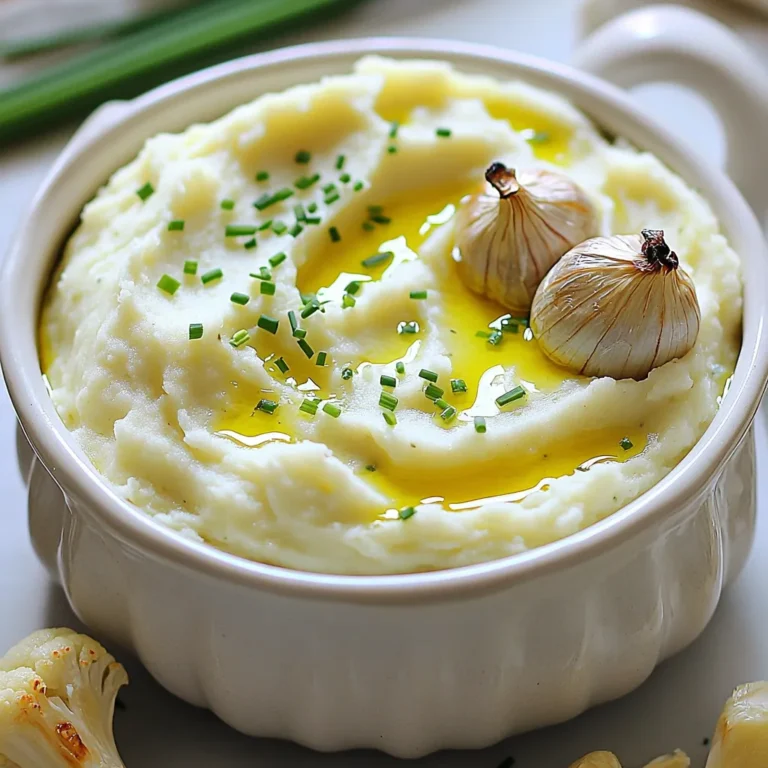
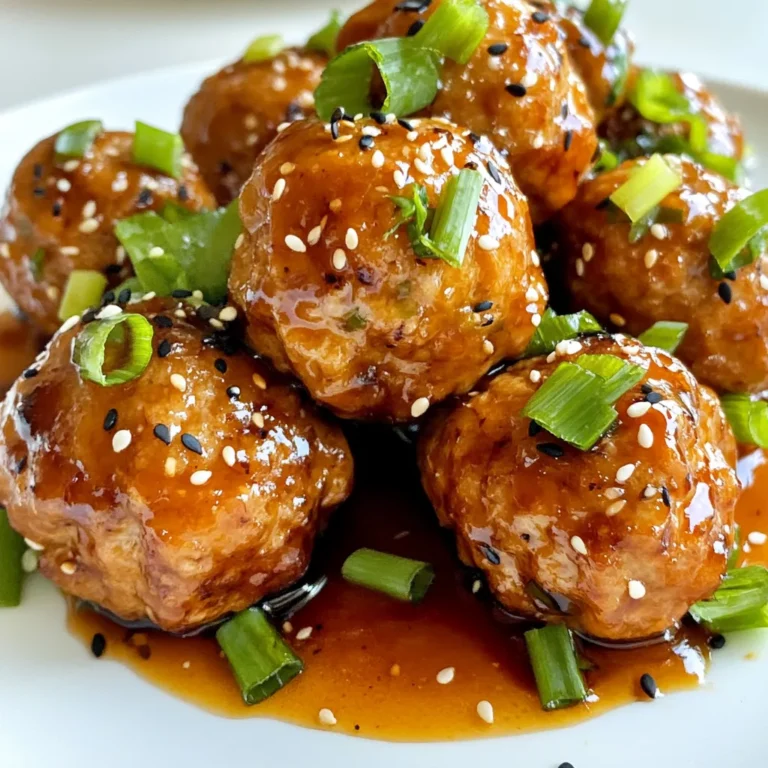
. To make One-Pan Garlic Herb Salmon, I start by gathering all my ingredients. This way, I avoid running around the kitchen. I always preheat my oven to 400°F (200°C). This ensures the salmon cooks evenly. I make sure to have a large baking dish or a lined baking sheet ready for the salmon. 1. First, I whisk together the olive oil, garlic, oregano, thyme, smoked paprika, salt, and pepper in a mixing bowl. This creates a tasty marinade. 2. Next, I place the salmon fillets skin-side down in the baking dish. I use a brush or spoon to coat each fillet with the marinade. I want to make sure each piece is well covered. 3. I then arrange lemon slices, halved cherry tomatoes, and zucchini around the salmon. I drizzle any leftover marinade over the veggies for extra flavor. 4. After that, I transfer the dish to the oven and bake for 12 to 15 minutes. The salmon should flake easily when done, and the veggies should look vibrant. 5. Once cooked, I take the dish out and let it rest for a few minutes. This helps the flavors blend better. 6. Just before serving, I sprinkle fresh parsley on top for a nice touch. To get the best salmon, I recommend using high-quality fillets. Fresh salmon tastes better than frozen. Keep an eye on the cooking time. Overcooking can dry out the fish. If you like crispy skin, place the salmon skin-side up under the broiler for the last minute. This gives it a nice crunch. If you're looking for the full recipe, check out the Full Recipe section. Enjoy your meal! To get crispy skin on your salmon, dry it well before cooking. Pat the skin with paper towels to remove moisture. This step helps the skin crisp up nicely. Use high-quality olive oil in your marinade. This oil helps the skin get golden and crunchy. Bake the salmon skin-side down, and avoid flipping it. This keeps the skin intact and crispy. For added flavor, try using fresh herbs instead of dried. Fresh parsley or dill adds a bright taste. Lemon zest is another great addition. It brings a fresh zing that pairs well with salmon. You can also add a splash of white wine to the baking dish. This adds depth to the sauce and enhances the overall flavor. One common mistake is overcrowding the pan. Make sure each salmon fillet has space around it. This helps the heat circulate and cook evenly. Another mistake is not checking for doneness. Salmon should flake easily with a fork. If you overcook it, it may become dry. Lastly, don’t skip the resting step after baking. Letting it rest helps the juices redistribute, leading to a juicier fillet. For the complete recipe, check out the Full Recipe section. {{image_4}} You can change up the veggies in this dish. Try using asparagus, bell peppers, or broccoli. These vegetables cook well and add color. They also provide different flavors. For a twist, add spinach or kale near the end of cooking. This keeps them bright and fresh. This recipe is naturally gluten-free and dairy-free. If you need to avoid gluten, ensure your ingredients are certified gluten-free. You can use coconut oil instead of olive oil for a different flavor. This keeps the dish healthy and tasty. You can cook this salmon in several ways. Besides baking, try grilling it for a smoky taste. To do this, preheat your grill and cook the salmon on medium heat. You can also pan-sear it on the stovetop. Just heat a non-stick pan and cook the salmon for about 4-5 minutes per side. Each method gives you a unique flavor and texture. For the full recipe, check out the One-Pan Garlic Herb Salmon Delight. After you enjoy your One-Pan Garlic Herb Salmon, store leftovers quickly. Place the salmon and veggies in an airtight container. This keeps them fresh and tasty. Make sure to cool them to room temperature before sealing. Store in the fridge for up to three days. If you want to keep it longer, freezing is a great option. When you're ready to eat leftovers, avoid the microwave if you can. It can dry out the salmon. Instead, preheat your oven to 350°F (175°C). Place the salmon and veggies on a baking sheet. Cover them with foil to keep moisture in. Heat for about 10 to 15 minutes, or until warm. You can also reheat in a skillet over low heat, adding a bit of olive oil to keep it moist. Freezing is a smart way to save your One-Pan Garlic Herb Salmon. To freeze, wrap each salmon fillet in plastic wrap, then place them in a freezer-safe bag. Remove as much air as possible before sealing. The veggies can go in the same bag or a separate one. This meal can last in the freezer for up to three months. When you're ready to eat, thaw it overnight in the fridge before reheating. Enjoy! You can tell salmon is cooked when it flakes easily with a fork. The fish should change from translucent to a light pink color. The internal temperature should reach 145°F (63°C). Always use a food thermometer for the best results. Yes, you can use frozen salmon! Just make sure to thaw it first. Place the salmon in the fridge overnight or use a quick method by sealing it in a bag and running it under cold water. This keeps the fish safe and helps it cook evenly. You can serve this dish with many sides. Try steamed rice, quinoa, or a fresh salad. Roasted vegetables pair well too. For a full meal, consider serving garlic bread or a light pasta. You can find the Full Recipe for One-Pan Garlic Herb Salmon here, which gives a complete picture of this delightful dish. In this blog post, we explored the best ingredients for making One-Pan Garlic Herb Salmon. I shared quality recommendations, possible substitutions, and step-by-step cooking instructions. You learned tips for achieving crispy skin and enhancing flavors. We discussed variations using different vegetables and cooking methods, along with storage and reheating tips. Remember, cooking salmon can be easy and fun. Stick to the tips and enjoy your meal! Check out the full recipe for detailed steps.](https://dishtreats.com/wp-content/uploads/2025/06/57d74547-3b02-425a-a5fa-1ca9189b97a5-768x768.webp)
. It takes about 20 minutes to cook garlic butter steak bites. You spend 10 minutes prepping the ingredients and another 10 minutes cooking them. This quick cook time makes it easy to enjoy a tasty meal in no time. Yes, you can use other cuts of steak. Ribeye, filet mignon, or flank steak work well. Just remember to adjust the cooking time based on the cut you choose. Each cut has its own flavor and texture, so pick one you like best. You can serve garlic butter steak bites with various sides. Here are some great options: - Creamy mashed potatoes - Sautéed vegetables like green beans or broccoli - Fresh salad with light dressing - Crispy garlic bread These sides add flavor and balance to your meal. You can also use toothpicks for easy serving at parties or gatherings. For more ideas, check out the Full Recipe for garlic butter steak bites. It offers tips on presentation and other serving suggestions. In this post, we covered how to make garlic butter steak bites using simple ingredients. You learned about the key steps, from preparing the steak to combining it with garlic butter. We also shared tips for cooking and presented flavor variations to try. Finally, we discussed storage tricks and answered common questions. Keep this recipe handy for a quick and tasty meal. Enjoy your cooking and the delicious bites you create!](https://dishtreats.com/wp-content/uploads/2025/06/daf37226-e56f-491f-87e9-6665894a306e-768x768.webp)
